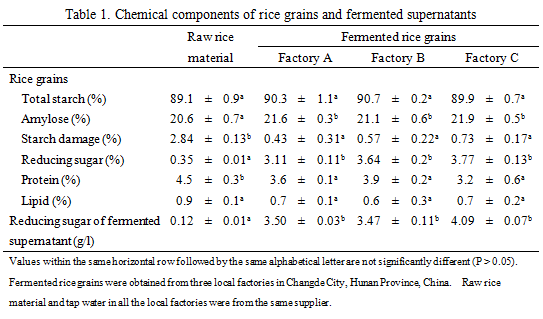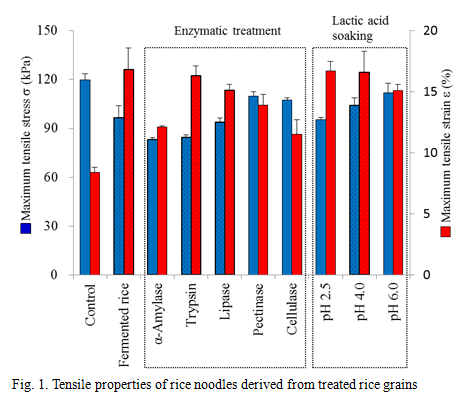Effect of natural fermentation on the textural improvement of traditional fermented rice noodles
Description
Natural fermentation of whole polished rice grains (Indica) is a traditional processing method widely applied in southern China and Southeast Asia to improve the texture of rice noodles. Though it is common knowledge that rice starch is degraded during fermentation resulting in poor gel strength, little is known about the effects of fermentation on texture characteristics of starch-based foods; hence, its effect on rice noodles remains unclear. Therefore, exploring the merits of fermentation is crucial in enhancing the quality of fermented rice noodles. The objectives of the present study are: (1) to isolate, identify and characterize the micro-organisms present during the natural fermentation process, (2) to determine the metabolites produced during fermentation and chemical component changes of raw milled rice grains, (3) to investigate their effects on rheological and sensory properties of rice noodles, and (4) to clarify the mechanism for improving the texture of fermented rice noodles.
A total of 170 lactic acid bacteria (LAB) and 96 yeasts were isolated from three local factories in Changde City, Hunan Province, China. Lactobacillus plantarum (32 strains)was more frequently isolated than other LAB species during the fermentation process. The number of Lactobacillus strains (83.5%) suggested that lactobacilli predominated in the fermented rice noodle processing. The predominant yeast species was Saccharomyces cerevisiae (57 strains). Table 1 shows the chemical components of raw rice material, fermented rice grains and fermented supernatant at 72 h in three factories. After fermentation, the contents of total starch and amylose, and reducing sugar increased, whereas the contents of starch damage, protein and lipid decreased. However, the changes on total starch and lipid were not significant (P > 0.05). Lactic acid was the dominant organic acid produced by fermentation.
Rice starch underwent slight hydrolysis during natural fermentation while its purity increased significantly. Treating the raw milled rice grains with trypsin, lipase or lactic acid (pH 4.0) could modify the rheological characteristics (Fig. 1) and improve the sensory properties of rice noodles. Removal of protein and lipid by a physical extraction method confirmed the result of protease and lipase treatments, indicating that the purity of starch is an important factor in determining noodle texture. Low molecular weight sugars should be rinsed completely from rice grains immediately after fermentation to minimize their negative effects on the tensile and sensory properties of rice noodles.
In conclusion, fermentation of raw milled rice by LAB and yeasts decreased protein and lipid content and increased the purity of rice starch, thereby improving the texture of fermented rice noodles. However, the low molecular weight sugars produced during fermentation should be removed for their negative effect on texture.
Figure, table
- Affiliation
-
Japan International Research Center for Agricultural Sciences Biological Resources and Post-harvest Division
- Classification
-
Administration B
- Research project
- Program name
- Term of research
-
FY 2011 (FY 2011-FY 2015)
- Responsible researcher
-
Tstsumi Eizo ( Biological Resources and Post-harvest Division )
MIERUKA ID: 001754Saito Masayoshi ( Program Director (Rural Livelihood Improvement), JIRCAS )
MIERUKA ID: 001752Kohyama Kaoru ( National Food Research Institute )
KAKEN Researcher No.: 00353938Lu Zhan-Hui ( China Agricultral University )
LI Lite ( China Agricultral University )
- ほか
- Publication, etc.
-
Lu et al. (2008) J. Appl. Microbiol. 105(3):893-903
Lu et al. (2008) J. Sci. Food Agric. 88(12):2134-2141
- Japanese PDF
-
2011_12_A4_ja.pdf118.74 KB
- English PDF
-
2011_12_A4_en.pdf100.36 KB


